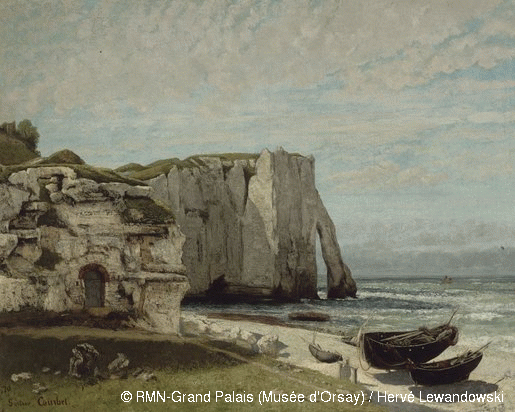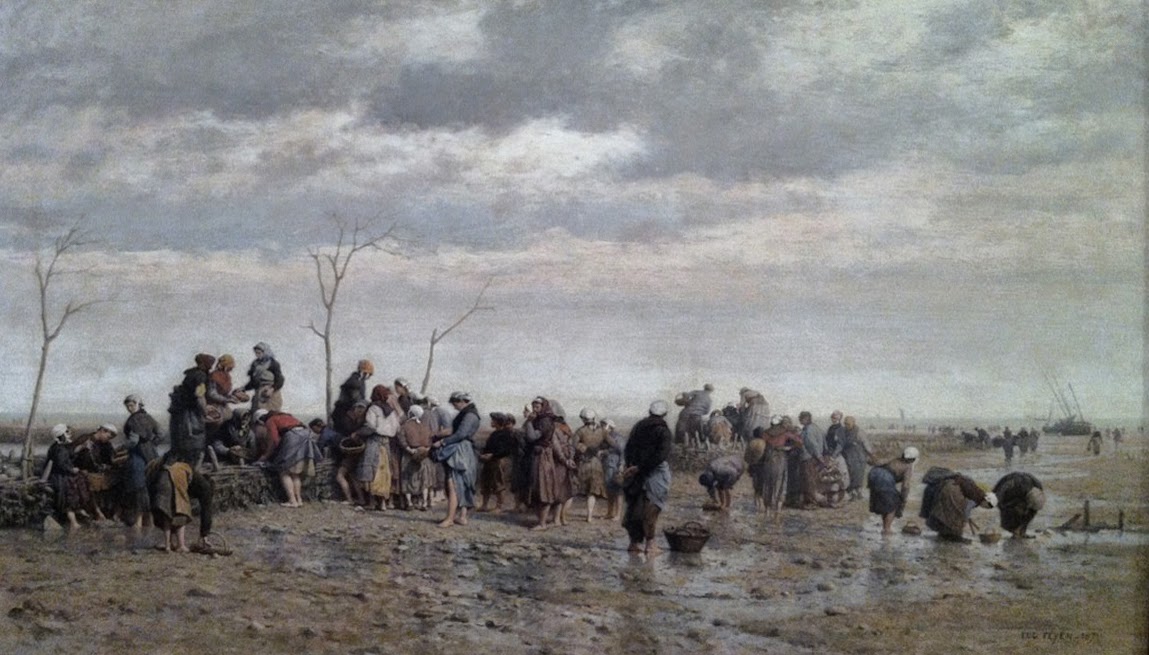 |
| Elodie La Villette, Chemin du Bas Fort Blanc, Dieppe, 1885, Musée de Morlaix (photo taken by the author in 2014 with permission) |
 |
| Gustave Courbet, The Cliffs at Etretat after a Storm 1870, Musée d'Orsay |
Her Salon debut was in 1870, and in 1875 she won a third-class medal. Over the course of her very successful career, she showed in London, Barcelona, Munich, Copenhagen, Chicago, Vienna, Namur, Amsterdam, Manchester, Ghent, and Brussels. In the 1870s and 80s, she was the only woman artist showing large-scale landscapes at the Paris Salons. La Villette also showed yearly with the Union des Femmes Peintres et Sculpteurs, the first exhibition society for women artists. Typical of the backhanded compliment that women artists often received, critic Henri Olleris in 1880 wrote of her work at the Palace of Industry in Paris that it showed a
completely virile talent. There is no trace of feminine weakness in these paintings. The land is solid, the horizons are distant, the sea is full of movement. The first impression produced, which is true, is that of a great sincerity and a great finesse of observation. These qualities, combined with a skill of execution, brings to light these works that most justly appreciated.
"No feminine weakness": such was the sort of praise one could only hope for as a woman who painted landscape and seriously engaged with the challenge of evoking a place. La Villette, especially in this painting, did not subscribe to a notion of feminine weakness-- quite the reverse.
Pouring over details from this remarkable landscape, and returning to photos I took on the beach, very near Dieppe, in 2012, I would like to explore the relationships in this painting between the small human figures and use some Rachel Carson's very poetic observations about marine biology in regard to what she termed the “interchangability of land and sea in this marginal world of the shore.”
 |
| Jean-Baptiste Antoine Guillemet, The Cliffs of Puys at Low Tide, 1877, Chateau Museum, Dieppe |
In the 1830s, like La Villette, romantic-era landscapist Eugène Isabey was interested in the life of those who work on the beach-- he includes a fisherman's shack and a wooden cart at the base of the cliffs.
 |
| Eugène Louis Gabriel Isabey, Le château de Dieppe (vu du bas de la falaise) (1830s?) |
 |
| Corot, Fisherman's Wife, Dieppe c.1822 |
 |
| A. Bayol, Dieppe, 1846 |
 |
| Le Pollet "Les Gobes", 1771 |
 |
| From an early 19th century series of engravings of the fisherpeople of Le Pollet, the fisherman's quarter of Dieppe. |
 |
| Cliff dwellers in "les Gobes," Dieppe |
The description of these regional "types" was also a staple of later post card photographers who sought out the cliff-dwelling fishers who lived so rudely, yet so close to the large port and fashionable beach of Dieppe. Some of these fisherfolk had been displaced from Le Pollet during the nineteenth-century industrial overhaul of the harbor. Some of the caves in the cliffs were abandoned stone quarries.
 | |
| Fishers' home in the cliff. |
The practice of re-using fishing boats as sheds or shacks seemed likewise a fascinating example of peasant thrift and economy.
Further up the coast, in Equihen, near Boulogne-sur-Mer, fishermen made homes called "quilles en l'air" with the no-longer seaworthy boats turned upside down, (today these are holidays cottages). Evincing the same fascination with peasant thrift and filth that I have written about in an earlier post, much of this imagery posits the fishers as ekeing out an existence on the margins of a place in the process of change.
 |
| Fishing family living in a home made from an overturned wooden boat know as "Quille en l'air," Boulogne sur Mer. |
 |
| La Villette, Chemin du Bas Fort Blanc, detail. |
 |
| detail |
Right at the edge of the sea are two barely visible figures, bent over, arms madly working. Are these children playing? People digging for shellfish or cutting seaweed exposed by the low tide?
 |
| detail |
To the right of the ship (traveling along on the horizon line) is another group of three figures (one may be a child) and further right, by a small boat are two more; one holds a red parasol. Are the two on the left part of a small boating party on the right? Like Monet, La Villette's staffage figures invite a curious eye as they depict recognizable gestures using a bare economy of means. La Villette’s marine landscapes often include human presences in the form of small figures in the foreground or staffage figures at a distance but they draw no hard distinctions between the
life of those on the shore and on the water, often including those figures who linger to look as well as those who
work the low tide, gathering shellfish and seaweed at its ebb.
Her figures do not loom large above the
horizon, as they do so often in Jules Breton’s heroic paintings. There is no room for anecdote or rags as in the images of fishers above. Even in comparison to Eugène Feyen's Gleaners of the Sea, which is packed with the silhouettes and postures of working in the intertidal world, La Villette's forms are less anecdotal, and do not break the horizon.
 |
| Eugène Feyen, Gleaners of the Sea, 1871 |
The most prominent figure in her Dieppe painting is a mostly black outline of a female figure (in a dark dress and white kerchief or coiffe) with a square shape behind her back.
 |
| La Villette, Chemin du Bas Fort Blanc, detail. |
 |
| detail |
Ulysses Butin was a naturalist painter much admired by Vincent Van Gogh, who often represented genre scenes of coastal peasants. In this painting (that recently showed up on the art market) he depicted women returning from picking mussels with their baskets.
Late nineteenth and early twentieth century postcards depict women of Normandy and the Channel coast carrying mussels in baskets on their arm (like Butin and Corot's painting above) and on their backs. However, the baskets are not worn higher than their heads and nets have nothing to do with mussel picking.
Nets were used for shrimp fishing, and this too was a favorite subject for artists and photographers.
But there is something else that Villette's woman might be collecting, that would lend a very interesting subject to this painting: this woman walking the beach at low tide, among the stones on the shore, rather than among the large rocks farther out where mussels grow, may be a rock picker.
 |
| Flint in chalk cliffs. source: http://craies.crihan.fr/?page_id=36 |
The chalk cliffs of this section of Normandy beaches were formed by the high yet shallow seas of the Cretaceous period (which gets its name from the chalk deposits laid down during this era). Carson, in The Sea Around Us (1951) discusses the layering of flint stones these cliffs and their poetic temporal resonance:
the chalk seems to be a shallow-water deposit, but it is so pure in texture that the surrounding lands must have been low deserts, from which little material was carried seaward. Grains of wind-borne quartz sand, which frequently occur in the chalk, support this view. At certain levels the chalk contains nodules of flint. Stone Age men mined the flint for weapons and tools and also used this relic of the Cretaceous sea to light their fires.
This somewhat loose sediment is shot through with seams and nodules of black flint (silex in French). Because of erosion, flint falls from the soft chalk cliff and becomes gradually rounded by the action of waves into hard, dark stones-- known in the area as "galets."
 |
| gathering stones at Le Tréport, 1920s |
Women collected the rounded rocks in baskets carried on their backs. Horses then pulled the heavy cartloads or transported large bins of stones from the beach.

In the Middle Ages, these flint stones had been used as projectiles. Many homes in Dieppe, Le Tréport and other towns in the area are made of these hard stones.
 |
| Detail of a building in Le Tréport showing flint in concrete. |
In more recent times they were exported to England and the US (sometimes as ballast) and were also ground down for use in cosmetics, medications and ceramics (a certain type of the sought after black stones were used by Wedgewood). Large scale collection of these stones for sale began in the late 18th century and was widespread by the time La Villette was working. Collection of "galets" was banned in 1985 (although in Cayeux sur Mer in Picardie, beach stones are collected en masse and industrially polished for a range of uses. The recent film Bord de Mer (2002) is set there.)
 |
| Bas Fort Blanc. from http://www.estrancitedelamer.fr/ |
 |
| flint nodules in the cliff |
 |
| foreground, detail |
Beyond them, to the right, are rocks covered in the green algae and seaweed of deeper water and shorter exposure to the air.
The time of the diurnal tides meets the time of labor, the time of vacation, the deep time of sedimentation and rapid erosion. As Carson wrote in the opening to her second sea book, The Edge of the Sea:
The edge of the sea is a strange and beautiful place. All through the long history of Earth it has been an area of unrest where waves have broken heavily against the land, where the tides have pressed forward over the continents, receded and then returned. For no two successive days is the shore line precisely the same. Not only do the tides advance and retreat in their eternal rhythms, but the level of the sea itself is never at rest. It rises or falls as the glaciers melt or grow, as the floor of the deep ocean basins shifts under its increasing load of sediments, or as the earth's crust along the continental margins warps up or down in adjustment to strain and tension. Today a little more land may belong to the sea, tomorrow a little less. Always the edge of the sea remains an elusive and indefinable boundary.
on the edge of a few tidal pools are newly fallen, black stones that litter the foreground of the painting, right in the path of the woman who heads toward us.
 |
| Gustave Courbet, Laundresses at Low Tide (known as The Seaweed Gatherers), 1866-68. Clark Art Institute, Williamstown. |
 |
| Courbet, The Cliffs at Etretat after a Storm 1870, detail. |
Like Courbet's paintings of Etretat, La Villette finds the shore occupied with human life. He had included miniscule laundresses washing clothing at the fresh water springs that rose up in the sand at low tide.
 |
| Laundresses at Etretat, from a vintage postcard. |
La Villette shows us many small figures, but the woman who may be a rock picker bears a very heavy burden in her harvest of stones.This was surely "no feminine weakness."
 |
| La Villette, detail |
Afterthought: After finishing this post, I found this image of a "Mussel Fisher" by Concarneau artist Alfred Guillou (but do not know why a mussel-picker would have a shrimping net).
Another afterthought: La Villette probably knew of this celebrated Salon painting (often mistakenly labeled "chicken woman" in English), whose eroticization of a fisherwoman could not be more distant from her artistic practice.
 |
| Antoine Vollon, Woman of Le Pollet at Dieppe, Salon of 1876 |















Hello, Maura, many thanks for your very interesting blog! Do you know a french painter, Charles Wislin (1852-1932), who liked drawing and painting the Treport?
ReplyDeleteLaurence Hermann